I want pair 2SJ28/2SK82 for SONY V-FET...
I want a pair of nice girls !
Both are way too expensive and unobtanium
Thanks everybody!
Dennis I don't know how much it weights.
I can't lift it from my desktop anymoreNeed assistance
I have to figure out how to put it on the bathroom scales, because it covers the whole scales and I'm not able to read the display...hahaha
Maybe it's too heavy, but standard practice for weighing difficult items (ie you pet dog) is to weigh yourself with and without holding the object.
You can also place the amp on a/some book(s) and peer down at the gap between the display and the amp to read the value for weight. Subtract the book weight if necessary (if it's more than 0.5 Kg / 1 lb).
Remember ... bring the scale to the amp, not the amp to the scale ;-)
Last edited:
Thanks! Still my best sounding amp. Listening to J2 and F6 now to compare.
Great collection you have there...please share some listening impressions once done.
Thanks! Still my best sounding amp. Listening to J2 and F6 now to compare.
Walter could you tell me your listening impressions of your Vfet amp vs the F5TV3?
Are you feeding it a balanced or SE signal?
Thanks, nash
Thanks! Still my best sounding amp. Listening to J2 and F6 now to compare.
I dont think neither of them will besten the sound. You should try F7 (or F5T) and XA25, probably the latter (which retails around 5.5k in Netherlands).
It wouldn't surprise me if Nelson Pass' sense of irony would prevail, and the XA25 would be the best sounding production Pass Labs amp. I heard it at the CAS and liked it. I also liked the XA 30.8, but conditions prevented any sense of shootout.
That being said, I think the DIY Pass VFET is one for the ages and may be among the best sounding amps. Being a non-commercial gift to the DIY community, not that many people will actually hear it.
I have the M2 too, and like that one as well.
VFET: black silences, absolute separation, abbreviated but deep, sweet, natural tone that seems to go down further into the instruments than any other design. It will articulate every instrument and voice, no confusing octave related instruments with each other. Vocal harmonies separated to perfection.
M2: Also high order performance. It has an organic whole-ism and interconnectedness to the soundstage tapestry that is hard to describe, while still being very detailed. It does surprising flashbulb pops of light and dimension on gathered instruments. Massed strings sound very natural and not at all solid state. PRAT is excellent. Less incisive than the VFET, but VFET lacks a bit of that organic connection the M2 has.
Well, there's my pretentious audio poetry for the day.
That being said, I think the DIY Pass VFET is one for the ages and may be among the best sounding amps. Being a non-commercial gift to the DIY community, not that many people will actually hear it.
I have the M2 too, and like that one as well.
VFET: black silences, absolute separation, abbreviated but deep, sweet, natural tone that seems to go down further into the instruments than any other design. It will articulate every instrument and voice, no confusing octave related instruments with each other. Vocal harmonies separated to perfection.
M2: Also high order performance. It has an organic whole-ism and interconnectedness to the soundstage tapestry that is hard to describe, while still being very detailed. It does surprising flashbulb pops of light and dimension on gathered instruments. Massed strings sound very natural and not at all solid state. PRAT is excellent. Less incisive than the VFET, but VFET lacks a bit of that organic connection the M2 has.
Well, there's my pretentious audio poetry for the day.
Another VFET-X lives!
I have recently finished my project on balanced VFET amplifier and would like to share the result with the community over here at DIY Audio.
A lot of ideas on the circuits and the arrangement of the amplifier came from the work of Walter as posted in this thread and therefore I am also posting here to revive the thread a bit, I hope that Walter doesn’t mind 😉. I would also like to say thank you to Walter at this point for the ground-breaking work and of course to Papa for all his contribution to the community.
The idea for this project came a long time ago in 2013 when I read Papa’s article on Sony VFET Commemorative amplifier and I thought that I want one! I was using an Aleph-X at that point and I was thinking that it would be great to have the same but with VFETs. And so, in early 2014 I bought a bunch of VFETs when they were still “widely” available from Circuit DIY thinking that one day I’ll build a similar amp. Later in 2014, our daughter was born and therefore the project was put on hold since suddenly there was no time available for almost anything. Then in 2016, I saw that Walter built his amp and my idea for this amp was reignited, I started to work on the design, but I still had no time to make much progress. In 2017, I found some time and I built the VFET2 amplifier from a kit offered at DIY Audio at that time (some info posted here https://www.diyaudio.com/forums/pass-labs/276711-sony-vfet-amplifier-2-a-294.html#post5045403 and visible behind the mono-blocks in the photo shown below). The VFET2 replaced my Aleph-X and it sounds great to this day. Last summer, I finally said to myself that it was enough delaying the whole Balanced VFET amp and I finished all the unfinished stuff and finally ordered the parts for it. The mono-block amps as built are shown below.
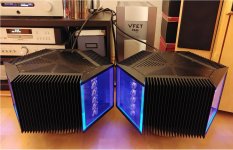
Since the very beginning I had the idea to build mono-blocks which would have hexagon shape. I also had the idea that the VFETs must be visible since they are such special devices! Therefore, I came up with a design where heatsinks are blended with some acrylic glass behind which the devices are fully visible.
The amp is split between three PCBs, a front-end PCB and two output stage PCBs (left and right).
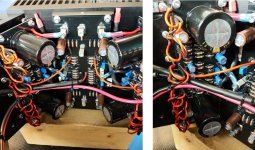
There’s also a bridge rectifier and filtering capacitors and soft-start circuit inside the box. The transformer is outside of the box and it serves as a stand for the enclosure itself.
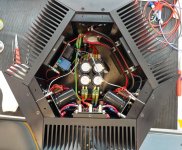
The Output stage is biased to have 1 A per VFET which means 4 A per channel. The transformer has the output voltage of 25 Vac which results in dc supply voltage of approx. 31.5 Vdc per rail and I adjusted the regulators to have +/- 24 V on the VFETs. This means that each channel is burning about 260 W per channel. The heatsinks get quite hot with so much power dissipation. Each channel settles at about 65 C on the front heatsink and 75 C on the VFETs themselves after a few hours of operation. This means that the enclosures are pretty much on the limit but stable, at least in winter for now 😉.
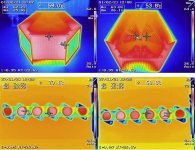
Sound-wise, this amp is a clear step up from the VFET2. Feeding the amp over a balanced cable directly from my DDDAC without any coupling capacitor or transformer. My setup at home with these amps is shown below. The setup right now has a great sound with incredible clarity and sound stage reproduction.
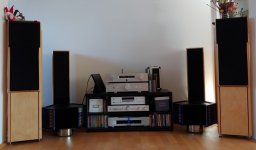
I was building the amps at work using tools and equipment that I have available in the lab. When I played the amps when finished using some cheap Yamaha speakers, many colleagues were impressed how much difference in sound an amp can make. Even with cheap speakers, the amp had very clear sound with superb tonality and definition.
At end I must say that I really like it, the effort was worth it, and this is one incredible amp with great sound that can serve as a room heater in winter as well 😉. Overall, it was much easier to put into operation than I anticipated. The biggest challenge were some mistakes that I made on the circuit boards. Another challenge was carrying the amps into our apartment on the 6th floor without an elevator since each mono-block weight approx. 30 kg!
Some additional photos of the amplifier follow.
Martin
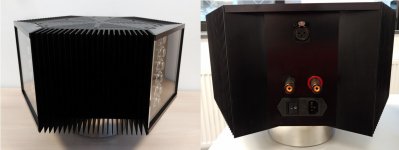
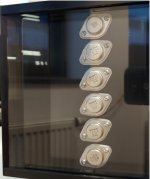
I have recently finished my project on balanced VFET amplifier and would like to share the result with the community over here at DIY Audio.
A lot of ideas on the circuits and the arrangement of the amplifier came from the work of Walter as posted in this thread and therefore I am also posting here to revive the thread a bit, I hope that Walter doesn’t mind 😉. I would also like to say thank you to Walter at this point for the ground-breaking work and of course to Papa for all his contribution to the community.
The idea for this project came a long time ago in 2013 when I read Papa’s article on Sony VFET Commemorative amplifier and I thought that I want one! I was using an Aleph-X at that point and I was thinking that it would be great to have the same but with VFETs. And so, in early 2014 I bought a bunch of VFETs when they were still “widely” available from Circuit DIY thinking that one day I’ll build a similar amp. Later in 2014, our daughter was born and therefore the project was put on hold since suddenly there was no time available for almost anything. Then in 2016, I saw that Walter built his amp and my idea for this amp was reignited, I started to work on the design, but I still had no time to make much progress. In 2017, I found some time and I built the VFET2 amplifier from a kit offered at DIY Audio at that time (some info posted here https://www.diyaudio.com/forums/pass-labs/276711-sony-vfet-amplifier-2-a-294.html#post5045403 and visible behind the mono-blocks in the photo shown below). The VFET2 replaced my Aleph-X and it sounds great to this day. Last summer, I finally said to myself that it was enough delaying the whole Balanced VFET amp and I finished all the unfinished stuff and finally ordered the parts for it. The mono-block amps as built are shown below.

Since the very beginning I had the idea to build mono-blocks which would have hexagon shape. I also had the idea that the VFETs must be visible since they are such special devices! Therefore, I came up with a design where heatsinks are blended with some acrylic glass behind which the devices are fully visible.
The amp is split between three PCBs, a front-end PCB and two output stage PCBs (left and right).

There’s also a bridge rectifier and filtering capacitors and soft-start circuit inside the box. The transformer is outside of the box and it serves as a stand for the enclosure itself.

The Output stage is biased to have 1 A per VFET which means 4 A per channel. The transformer has the output voltage of 25 Vac which results in dc supply voltage of approx. 31.5 Vdc per rail and I adjusted the regulators to have +/- 24 V on the VFETs. This means that each channel is burning about 260 W per channel. The heatsinks get quite hot with so much power dissipation. Each channel settles at about 65 C on the front heatsink and 75 C on the VFETs themselves after a few hours of operation. This means that the enclosures are pretty much on the limit but stable, at least in winter for now 😉.

Sound-wise, this amp is a clear step up from the VFET2. Feeding the amp over a balanced cable directly from my DDDAC without any coupling capacitor or transformer. My setup at home with these amps is shown below. The setup right now has a great sound with incredible clarity and sound stage reproduction.

I was building the amps at work using tools and equipment that I have available in the lab. When I played the amps when finished using some cheap Yamaha speakers, many colleagues were impressed how much difference in sound an amp can make. Even with cheap speakers, the amp had very clear sound with superb tonality and definition.
At end I must say that I really like it, the effort was worth it, and this is one incredible amp with great sound that can serve as a room heater in winter as well 😉. Overall, it was much easier to put into operation than I anticipated. The biggest challenge were some mistakes that I made on the circuit boards. Another challenge was carrying the amps into our apartment on the 6th floor without an elevator since each mono-block weight approx. 30 kg!
Some additional photos of the amplifier follow.
Martin


- Home
- Amplifiers
- Pass Labs
- VFET-X (or my 1/3 40th Anniversary Sony VFET Clone)

